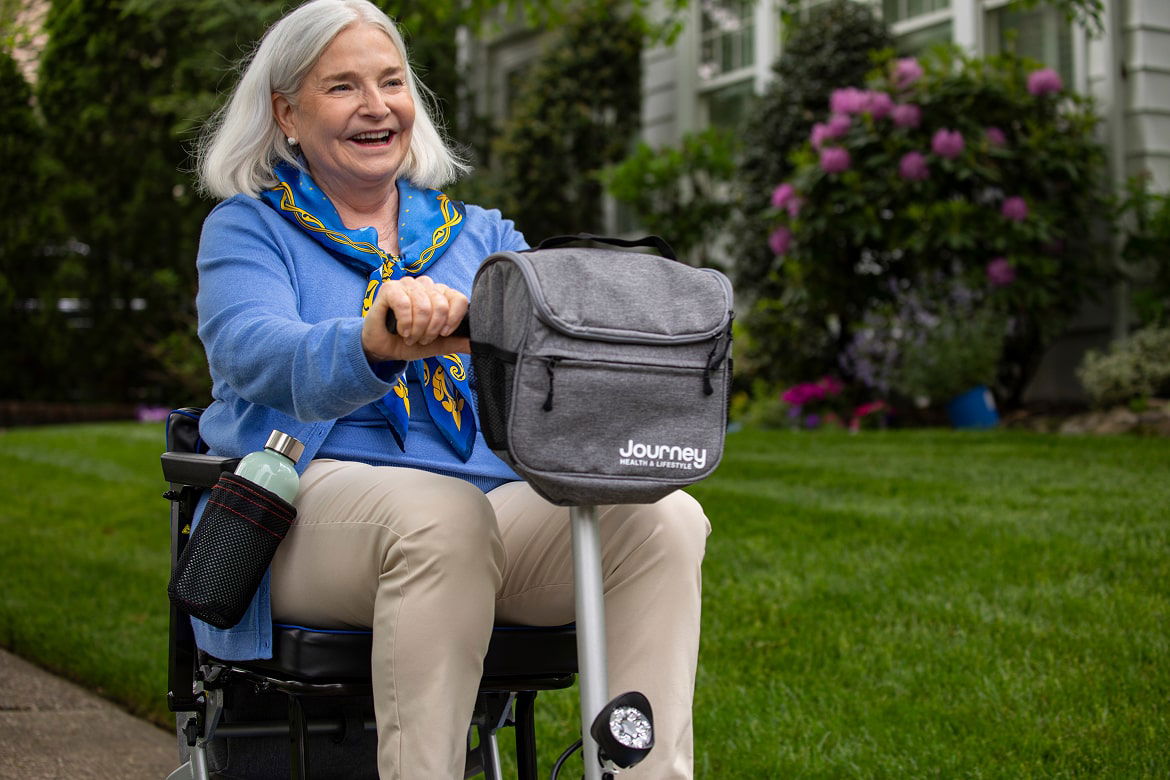M-F 9:30am - 7pm EST
Quick Maintenance Tips for Walkers, Power Chairs, and Scooters

Did you know a well-maintained mobility device can help prevent breakdowns that disrupt your day?
Your mobility device is your key to independence. Keeping it clean and well-maintained protects your safety and comfort. Mobility aid maintenance also helps your equipment last longer.
In this article, discover easy, practical tips for maintaining everything from power chairs to mobility scooters. Whether you are an older adult or a caregiver, you’ll find steps anyone can take to keep mobility aids performing their best.
Why Cleaning and Maintenance Matter
Regular cleaning reduces the risk of mechanical failures that might cause accidents, while keeping surfaces free from residue minimizes the chances of slips and falls. Using a clean, well-maintained mobility aid can improve self-esteem and personal comfort. Sitting in a dirty chair detracts from dignity, while taking pride in the care of a mobility device reflects a commitment to health and safety.
Keeping the surfaces of mobility devices clean can significantly reduce the risk of bacterial and viral infections, especially after visiting crowded places or during cold and flu season. Disinfecting handles, seats, and other contact points helps eliminate pathogen buildup and protects both users and those around them.
Routine maintenance, such as removing dust, lubricating moving parts, and tightening connections, prevents premature wear and tear on vital components like wheels, brakes, and frames. Clean mobility aids last longer and function better, which means fewer unexpected breakdowns and lower repair costs over time.

General Cleaning Tips: Safe Cleaning for Mobility Aids
Safe cleaning for mobility aids starts with gentle products and careful attention to high-contact surfaces. Start by checking the manufacturer's instructions to confirm the recommended cleaning details for your device.
- Remove any detachable parts, like cushions or baskets, for thorough cleaning.
- Wipe the device with a dry microfiber cloth to remove dust and debris.
- If needed, make a solution of mild soap and warm water. Dampen a cloth and use it to gently wipe all non-electronic surfaces. Dry all parts with a clean, dry microfiber cloth to prevent moisture damage and corrosion.
- Use a soft-bristled brush to clean small crevices and joints.
You can use diluted alcohol solutions or manufacturer-approved disinfectants for disinfecting walkers and scooters. Disinfect handles, armrests, seats, and controls with disinfectant wipes or sprays approved for medical equipment. Make sure the disinfectant is suitable for your device's materials. Perform a spot test on a small area to make sure there's no surface damage before using the product on a wider surface. Don't spray directly onto electronic controls or LED displays.
Avoid harsh chemicals including undiluted bleach, ammonia, and abrasive cleaners. They can degrade finishes and weaken parts. You'll also want to stay away from synthetic detergents, concentrated alcohol, and products that aren't marked as safe for medical equipment.
Safe Cleaning for Mobility Aids by Device
While you can typically follow the above tips for cleaning your mobility aid, each type of aid has slightly different care and maintenance needs. Here we’ll share how to approach cleaning walkers, power chairs, and mobility scooters.
How to Maintain Walkers
- Wipe down your walker’s frame and grips weekly. Remove debris with a dry microfiber cloth.
- Regularly check the rubber tips on the legs for wear. Replace the tips if they appear to be cracked or slippery.
- Make sure all foldable joints are clean and move smoothly.
Power Chair Maintenance
- Keep your power chair’s joystick and control panel free of dust. Use a dry cloth to remove any dust or debris.
- Disinfect the power chair’s armrests, seat cushions, and backrests regularly.
- Inspect wheels and batteries monthly.
- Keep battery terminals clean and dry.
- Store your power chair indoors to prevent moisture damage.
Both power chairs and mobility scooters require additional maintenance and consideration for battery maintenance. Keep reading to learn more about power chair battery maintenance.
Mobility Scooter Cleaning
- Clean your mobility scooter’s seat and handlebars with a damp cloth and mild soap.
- Regularly inspect the tires for wear and make sure they’re at the correct pressure.
- Keep battery terminals clean and dry.
- Protect your mobility scooter from weather by storing it indoors or in a covered area.
Power Chair and Scooter Battery Maintenance
Maintaining the batteries for power chairs and mobility scooters begins with regular charging. Always use the proper charger provided by the device manufacturer. To help prolong battery life, avoid letting the battery get below 20-30%. Refer to the battery strength as indicated by the LED lights on the control panel of your device for true battery strength once the charger is disconnected and the device is turned on.
Charge batteries nightly or after each use, even if they’re not fully drained. This maintains battery health. Don’t interrupt battery charging cycles. For lead-acid batteries, never leave the charge connected for more than 24 hours at a time.
Store power chairs and mobility scooters in a cool, dry place. The ideal temperature is between 50 and 86°F (10–30°C). Extreme heat or cold can reduce capacity and damage the battery.

As you begin using a new battery, it may require 10-20 full charge and discharge cycles to reach peak capacity. Be sure to avoid deep discharges during this time. If you’re not planning to use your device for some time, fully charge the batteries and top them off every couple of weeks. If you’re storing the device long-term, disconnect the batteries.
Regularly check battery terminals for dirt and condensation. Keep them clean and greased. To minimize battery drain, avoid overloading your mobility device, keep the tires properly inflated, and avoid making abrupt starts and stops. To avoid electrical and charging issues, avoid using the device navigating through wet conditions such as puddles, rain, snow and slush.
Following these steps will keep batteries strong, extend their lifespan, and ensure safe, reliable mobility.
Seasonal Mobility Device Maintenance Checklist
Preventing rust and moisture damage is critical during winter months. Clean your mobility device frequently after exposure to wet, icy, or salty conditions. Use a damp cloth and dry the device completely to prevent rust.
Regularly look for signs of corrosion on metal components like bolts, screws, and the frame. You can apply anti-rust spray to exposed metal to help prevent damage. Store your mobility aid indoors whenever possible to avoid battery drain and moisture buildup.
Maintain battery charge for powered devices. Check tires regularly to ensure they have adequate tread. Use protective covers to shield your device’s frame and electrical parts from snow, rain, and humidity for optimal winter maintenance. Do not attempt to use your mobility device while using a protective cover. Such coverings could become overheated or entangled in the wheels and drive mechanisms that could result in personal harm or device damage.
In warmer weather, store your mobility device in a cool, shaded place to prevent overheating of electronic components and battery. Don’t leave batteries or devices in direct sunlight for extended periods. Heat can reduce battery life and damage sensitive parts. Regularly inspect electrical connections and tires during summer months, as heat can accelerate wear.
Effective seasonal scooter care and walker maintenance will extend equipment life and ensure reliable, safe operation throughout the year.
When to Bring in a Professional
Preventative maintenance and regular cleaning can keep your mobility device working optimally, but some issues require professional service. If you’re seeing signs that repairs or replacement parts are needed, such as unusual noise, reduced battery performance, parts that feel loose, or difficulty steering, call a service professional.
Additionally, professional inspections are recommended every 6-12 months to keep powered devices running smoothly. You can find a mobility specialist near you by searching our list of providers to get professional mobility device repair and cleaning services in your area.
Set Up a Cleaning Routine
Routine cleaning and care can keep your walker, power chair, or mobility scooter safer and cleaner while extending the life of the device. Create a maintenance checklist and make mobility device cleaning part of your routine.
Frequently Asked Questions: Cleaning and Maintaining Walkers, Power Chairs, and Mobility Scooters
1. How often should I clean my walker or mobility scooter?
It’s best to wipe down mobility aids at least once a week. High-touch areas like handles, armrests, and seats should be disinfected more frequently, especially if used daily or in public places.
2. What cleaning products are safe to use on mobility devices?
Use mild soap, warm water, and a soft cloth for most surfaces. For disinfecting, a gentle non-bleach disinfectant or a 70% alcohol wipe is safe. Avoid harsh chemicals, which can damage rubber, upholstery, and electronics.
3. Does my mobility device need to be lubricated?
While the user guide does not require such maintenance, it can be a good practice to occasionally lubricate moving joints to ensure smooth functionality and extended life. Please use lubricants sparingly and wipe off excess, so as not to cause slippery or stained floors.
4. How do I maintain the battery on a power chair or mobility scooter?
Recharge batteries after each use instead of letting them drain completely. Keep battery terminals clean and dry. If you won’t be using the device for a long time, disconnect the battery or recharge it every few weeks. Do not keep the battery plugged into the charger for longer than an overnight period, usually about 6-8 hours.
5. When should I replace walker tips or rubber grips?
Replace tips immediately if they look cracked, worn, or slippery. For grips, check for peeling, stickiness, or loss of cushioning. Worn parts can reduce safety and stability.
6. Can I clean the seat cushions on my power chair or scooter?
Yes. Most seat cushions have covers that can be removed and hand- or machine-washed. Always check the manufacturer’s instructions, and avoid soaking foam inserts, as they can trap moisture and bacteria.
7. What’s the best way to store a mobility scooter or power chair?
Keep it indoors in a dry space. If storing in a garage or shed, use a breathable cover to protect it from dust and moisture. Avoid leaving batteries in extreme cold or heat.
8. How do I know if my mobility aid needs professional servicing?
If you notice unusual noises, difficulty steering, reduced battery performance, or parts that feel loose, it’s time to call a service professional. Regular inspections every 6–12 months are recommended for powered devices. You can also choose to call a Journey Health and Lifestyle troubleshooting expert to review the issue prior to contacting a local technician.










